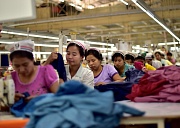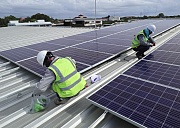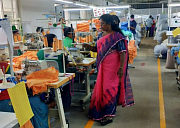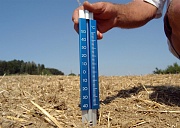So, let’s say textiles is around 1.5% of total GHG emissions. But then we need to add the GHG emissions related to the production of chemical processes such as ammonia, cleaning products, plastics, fertilisers, pesticides and indeed synthetic textiles. These together make 2.2% of the global total. So, let’s be aggressive and steal another 0.5% for textiles from there.
Then agriculture is responsible for 18.4% of global emissions. Cotton and other fibre crops represent around 1% of global agricultural land, but let’s be aggressive again, and say they represent 3% of agricultural emission so we can add another 0.5% to our total.
Adding these three figures together: 1.5% + 0.5% + 0.5% gives us a reasonable estimated 2.5% of global GHG emissions for the textile industry (including all non-apparel uses).
Another approach would be to use the online personal footprint calculator from ADEME, the French Agency for the Environmental Transition. Here, the average French consumer is listed as having a 450 kg CO2e on a total consumption footprint of 9,230 kg CO2e or 4.8% of the total.
The French consumer has a higher-than-average clothing footprint, but by how much? This can be approximated through comparison to the total global per capita GHG emissions of 6.7 tons which is 27% below the French average. Or differently and more specifically, through global average clothing consumption of about 4-5 kg per capita compared to about 10 kg in France. So global GHG clothing footprint per capita consumption should be between 40% and 73% of the French 4.8% figure, so again let’s round it to 2-3.5 % of global GHG emissions.
There is just no way we get to anywhere near the 10% of global GHG emissions that can be ascribed to the textile, the apparel, the fashion or let alone the fast fashion sector
Between the 1.8% by Apparel Impact Institute and the reality-corrected Quantis figure of 4.4% and all the other studies and my calculations in between, there is just no way we get to anywhere near the 10% of global GHG emission that can be ascribed to the textile, the apparel, the fashion or let alone the fast fashion sector. I would set my 80% confidence interval at between 2-3%.
Why does using the wrong values matter?
A quote accredited to German physicist Max Planck says: “Science advances one funeral at the time” – meaning that once researchers and academics have adopted a fundamental scientific belief or worldview, they will never change their opinion, unwilling to be proven wrong.
Sadly, I believe, we cannot expect much else from all the textile sustainability researchers, activists or policy makers that have hitched their wagon to the ‘fast fashion is killing the planet’ narrative.
Or as Charlie Munger (former right-hand man to famous investor Warren Buffet) said more succinctly: “Show me the incentives and I’ll show you the outcome”. There are powerful incentives that have been built into all these systems that will make the protagonists try to perpetuate the story.
Research papers and public funding for scientists, charity, industry and public funds for NGOs, political commitments and legislative initiatives for policy makers and their executive branches and big private and public contract dollars, euros... for the global consulting giants, testing and certification agencies etc.
Hanlon’s razor
Another explanation for the persistent use of the incorrect 10% emission figure is what is commonly known as Hanlon’s razor: “Don't ascribe to malice what can be explained by incompetence.”
In other words, the reason many people use the 10% figure is that they simply don’t know any better, or don’t bother to think for themselves and just copy what they find somewhere on the internet or in some authoritative looking publication. That is why it’s concerning that institutions such as the United Nations, the European Parliament or Commission and many top-level media outlets don’t bother to fact-check.
Now that we know why the 10% figure is out there and why it is likely to stay in circulation and (motivated) use for a long time to come, should we be bothered?
The answer to that is an emphatic yes, because there is a huge and important difference between 2-3% and 10% because GHG reduction measures are not costless. If it was possible to shave 5% off global emission over a decade by halving the textile industry’s CO2 intensity, it would be a worthy target, and should be actioned if the trade-offs are manageable.
But if all that can be achieved is a mere 1-1.5% reduction for the same efforts, then a detailed explanation of the related costs and trade-offs would need to be provided before I could get on board. Alternative measures that can achieve the same or greater GHG reduction targets for much lower costs, would also need to be explained.



























































































